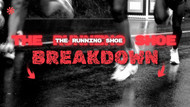The Running Shoe Breakdown
27th Aug 2025
Finding the perfect running shoe doesn’t have to be a sprint, running is one of the simplest and most rewarding ways to stay active, but having the right pair of shoes makes all the difference. The right footwear not only improves performance but also protects against injuries and makes every mile feel more comfortable. Choosing a pair of running shoes goes hand in hand with understanding the surfaces you’ll be running on. Let’s break it down.
Step 1: Know Your Running Style
Before picking your shoes, think about how and where you run:
-
Short daily jogs or long-distance training? Cushioning and support may matter more the farther you go.
-
Do you run on city streets, trails, or a mix of both? Surfaces play a big role in shoe choice.
-
Neutral stride or pronation issues? Some shoes are designed to stabilize your gait and prevent rolling inwards or outwards.
Step 2: Match the Shoe to the Surface
Different terrains require different support, grip, and cushioning.
-
Road Running (pavement, sidewalks, treadmills):
Shoes designed for roads are lightweight with flexible cushioning to absorb the impact of repetitive strides on hard, flat surfaces. Great for city runners or those sticking to treadmill training. -
Trail Running (dirt paths, rocky terrain, grass):
Trail shoes have deeper lugs for grip, tougher outsoles for durability, and protective features like rock plates. Perfect if you enjoy nature runs, uneven ground, or hilly areas. -
Track Running (rubberized tracks at schools or gyms):
Track shoes focus on speed and lightness. They often have minimal cushioning since the surface itself absorbs shock. Some advanced runners even use spikes for sprinting. -
Mixed Terrain (roads, gravel paths, park runs):
Hybrid shoes combine the flexibility of road shoes with some of the traction of trail shoes. Ideal if your routes switch between concrete and light off-road.
Recommended Running Shoes from Lifestyle Sports
-
Nike Women’s Vomero 18
A soft, durable road-running shoe with ZoomX foam cushioning and breathable mesh—ideal for high-mileage neutral runners. - Nike Air Zoom Pegasus 40 (Women) – Smooth ride that balances heel and forefoot strikes, ideal for both daily runs and tempo sessions.
-
Saucony Men's Ride 18
A responsive, neutral daily trainer featuring the PWRRUN+ midsole—great for everyday pavement runs. -
Saucony Men's Hurricane 25
Provides plush cushioning and strong stability—perfect for overpronators or high-mileage road runners.
| Terrain Type | Ideal Shoe Choice | Why It Works |
|---|---|---|
| Pavement / Treadmill | Vomero 18, Ride 18, Hurricane 25, 680v7 | Cushioning, stability, daily comfort |
| Natural Running / Zero-Drop Enthusiasts | Altra Torin 8 | Natural foot positioning, roomy toe box |
| Speed Work / Racing | Adidas Adizero SL | Lightweight design optimized for performance |
Shoe Care & Longevity Tips
Running shoes are an investment, so taking care of them matters:
-
Rotate between two pairs if you run often—this gives cushioning time to recover.
-
Let them air dry after wet runs (avoid dryers or direct heaters).
-
Use your running shoes only for running—wearing them as casual shoes wears them out faster.
1. Importance of Socks
The right socks can be just as important as shoes: moisture-wicking running socks reduce blisters and help with overall comfort.
2. Listen to Your Body
Even with the right shoes, soreness or discomfort may mean it’s time to swap shoes, adjust surfaces, or change training load. A good pair of shoes should help you feel supported, not sore.
3. Professional Fitting
If you’re unsure, visit a Lifestyle Sports store for expert advice. Staff can recommend shoes based on your stride, mileage, and goals.
Running shoes aren’t just about style—they’re tools that protect your body and enhance performance. Caring for your shoes, pairing them with the right socks, and paying attention to how your body feels are all part of the journey.
Remember: What works for one runner may not work for another. If you’re ever in doubt, Lifestyles Sports experts are here to guide you toward the perfect fit, so you can focus on enjoying the run—wherever the road, trail, or track takes you.







